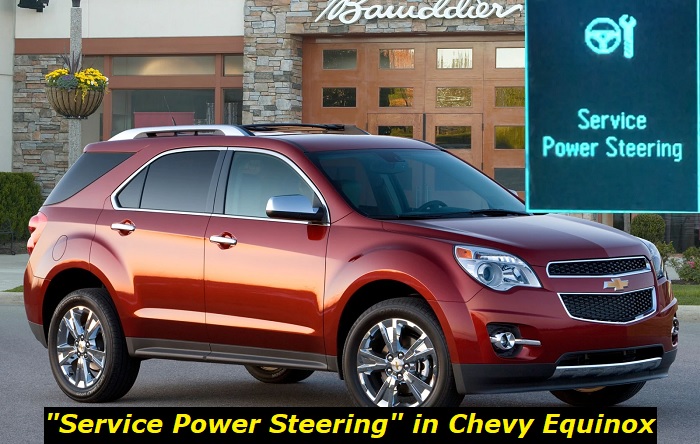If your Chevy Equinox is displaying the service power steering message, you have every right to be concerned. Your power steering system ranks high on the list of your vehicle's unsung heroes. It works hard to ensure you do not have to turn your Chevy's wheels manually. If you are wondering what to do about the warning on your dashboard, this article is just what the doctor ordered.
Service power steering message highlights
- Common reasons:battery problems, software glitches, bad power steering
- How to fix:check the battery, update the software, use the scanner to read codes
- Possible consequences:loss of power steering
- Priority level:Medium
- Can you drive?Carefully
- DIY repair:Possible
- Repair price range:$0-$900

Can You Drive with a Service Power Steering Message Displaying on Your Dashboard?
Driving while your Chevy displays a service power steering message is not advisable. A malfunctioning power steering significantly affects the handling of your car. If you can afford to have your car towed to the dealership or a reliable auto repair shop, do so immediately after the warning appears. Otherwise, drive carefully to the nearest repair shop for a diagnosis.
When driving a car displaying the service power steering message, you must steer it manually. The increased response time for manual steering means avoiding high speeds and being more alert than usual.
Common Cause of the Service Power Steering Message in Your Chevy
Here are the most common causes of a service power steering message in your Chevy.
1) Your Hydraulic Fluid is Contaminated or Insufficient
Your power steering system has a hydraulic fluid and pump system that magnifies the slight force you apply to the steering wheel. The pumping force will be severely compromised if your hydraulic fluid gets contaminated with dirt or debris. Similarly, insufficient power steering fluid will prevent your system from functioning optimally.
For the fluid to apply pressure on the rack and pinion's piston, the fluid must be sufficient and free of any contaminants. Low levels and contamination will compel you to apply more force than usual when steering your Chevy at hard turns or rough terrain.
Solution
Whenever you see your service power steering warning light, your first instinct should be to check your fluid levels. Ensure your system is not leaking because topping up will only do a little good then. A red puddle under your parking spot is the most common sign of leaking power steering fluid.
2) Your Steering Pump is Damaged
As your Chevy ages, the steering pump will likely undergo natural wear and tear. Wearing out of your steering pump will make it less effective, especially when handling sharp turns on rough terrain. You will need to apply additional force to turn your wheels because the strained pump cannot apply the optimal pressure.
Solution
Drivers must replace damaged steering pumps with new high-quality OEM alternatives. Ensure your replacement is done at the dealership or reliable auto repair shop. It is the best way to avoid unnecessarily being duped into replacing a steering pump.
3) Your Power Steering Belt Is Damaged
Your steering is connected to the engine using a belt. These belts are subjected to a lot of pressure and are liable to break due to wear and tear corrosion or excessive stretching. If your belt is loose or cracked in certain areas, you may feel your Chevy hesitating or becoming stubborn on rough terrain or at sharp turns. Your power steering belt is very hardy and thus is unlikely to break.
Solution
If you suspect a damaged power steering belt is the cause of your service power steering light, you will need to consult a professional. Replacing a power steering belt is a skilled procedure that needs proper tools, training, and experience. Wherever you choose to get the job done, ensure your belt is replaced with a high-quality OEM part.
4) Your Steering Rack is Malfunctioning
Your Chevy steering rack is the most important component of the steering system. Drivers who often ride offroad are the most likely to suffer a damaged steering rack. Once your steering rack begins to wear out, your vehicle will become very hard to steer, especially when it is cold. Once your vehicle heats up, the steering rack lubricates properly, and the difficulty will likely dissipate.
Solution
Book an appointment at your dealership to ensure your worn steering rack is replaced with a high-quality OEM spare part.
What Does the Service Power Steering Message Mean?
The service power steering message on your Chevy means that you can no longer rely on your vehicle's power steering system to function effectively. The malfunction could lie anywhere in your power steering system. The best way to learn more about the source of the problem is by connecting your vehicle to an ODB II scanner for a more precise code.
The most common diagnostic trouble codes associated with the power steering system are:
- P0637 - Power Steering Control Circuit High and
- P0550 - Power Steering Pressure Sensor Circuit Malfunction
The P0637 Code - Power Steering Control Circuit High
Your power steering control circuit is tasked with sending relevant data to your transmission control, traction control, cruise control, and fuel injection control modules. If any of these modules detects a malfunction in your steering control circuit, the P0637 code is likely to be triggered.
This code is most commonly caused by a defective power steering position or pressure switch. Other causes include:
- Wiring problems, e.g., defective ground wire
- Malfunctioning control area network bus.
- Loose or damaged control module ground straps
Symptoms of the P0367 code include:
- A service power steering message,
- An illuminated check engine light
- Heavy or hesitant steering wheel
- An erratic steering wheel that cuts off and activates on a whim
The P0550 Code - Power Steering Pressure Sensor Circuit Malfunction
Your power steering pressure sensor ensures your car handles smoothly. It communicates your car's positions to the ECU, which then calculates the appropriate amount of force that should be applied to turn your wheels to the proper angle.
The ECU also factors in data sent by your SAS (steering angle sensor) and PCM. Should the ECU receive conflicting data from the SAS and power steering pressure sensor, your power steering pump will lack crucial data, thus generating the P0550 code.
Any of the following problems could cause the P0550 code behind your Chevy's service power steering message:
- A damaged power steering pressure sensor
- Defect power steering pressure sensor circuit
- Insufficient or contaminated power steering fluid
- Defective or loose power steering pressure sensor connectors
- Damaged steering pump
- Malfunctioning rack and pinion
The P0550 code is likely to be accompanied by these symptoms:
- Stalling at low speeds
- Increased fuel consumption
- Power steering fluid leaks
- Failure of the power steering system
- Check engine light
Troubleshooting the P0550 and P0637 Error Codes
- The first step is confirming that your battery is sufficiently charged and in good health.
- Check your power steering fluid levels and top up if necessary. Inspect your parking spot for any signs of a leak. Inspect your sensor and ensure it is not the source of the leak.
- If the power steering fluid is leaking, you must locate the source of the leak and fix it. Power steering systems are highly pressurized. Do not interfere with the system if you are not an advanced DIYerTest your car and check whether the servicing error message persists.
- Refer to your service manual for the proper specifications for testing your sensor and circuit. Most of the time, the sensor is located on a power steering line and can be accessed from under your hood. Leaks often occur where the pressure line meets the rubber.
- Find your pressure sensor's electrical connector and inspect it for signs of damage. It will need some attention if your sensor looks corroded, melted, or coated in oil residue. Ensure you disconnect the battery before cleaning, repairing, or replacing your connector.
- Inspect your sensor for physical damage that may cause any electrical problems. Physical damage is often caused by the connector rubbing against another component. Refasten the line the sensor is connected to
- Finally, rule out damage to the wiring harness system by disconnecting the circuit at the ECM and sensor. Use a multimeter to ensure that all values are within the range recommended in your Chevy's user manual.
Final words
If your Chevy Equinox gives you the service power steering warning, it is best to comply with the direction. Most power steering repairs and replacements are not very costly, so you should not hesitate. Take your Chevy Equinox to the dealership or reliable auto repair shop for efficient diagnosis and repairs today.
About the authors
The CarAraC research team is composed of seasoned auto mechanics and automotive industry professionals, including individuals with advanced degrees and certifications in their field. Our team members boast prestigious credentials, reflecting their extensive knowledge and skills. These qualifications include: IMI: Institute of the Motor Industry, ASE-Certified Master Automobile Technicians; Coventry University, Graduate of MA in Automotive Journalism; Politecnico di Torino, Italy, MS Automotive Engineering; Ss. Cyril and Methodius University in Skopje, Mechanical University in Skopje; TOC Automotive College; DHA Suffa University, Department of Mechanical Engineering






Add comment